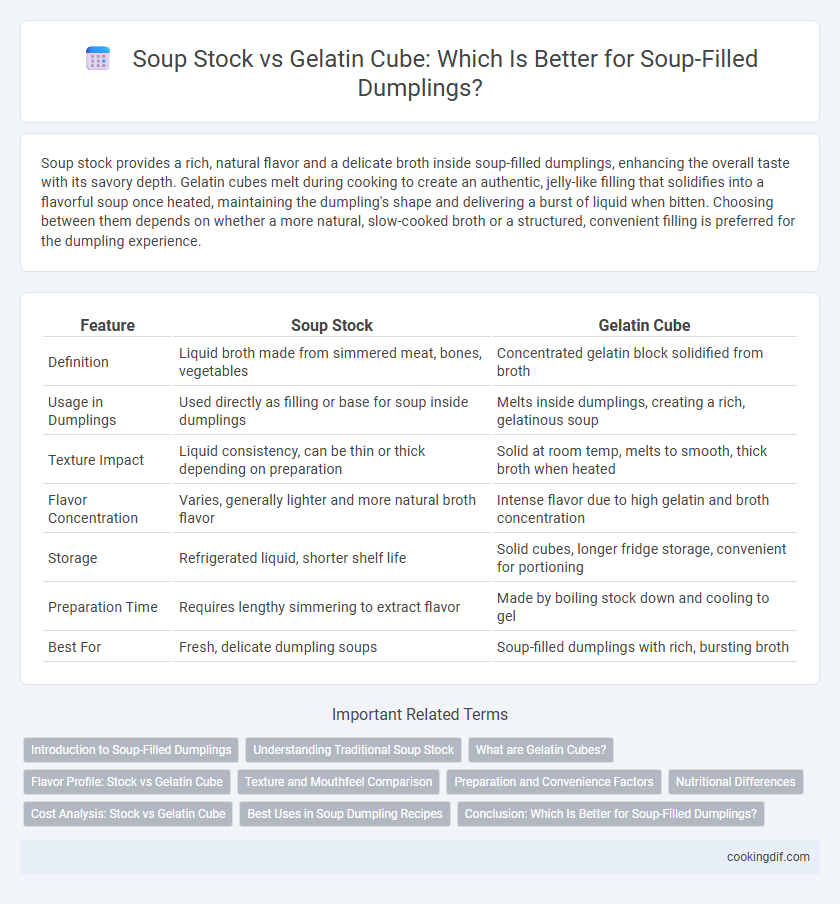Soup stock provides a rich, natural flavor and a delicate broth inside soup-filled dumplings, enhancing the overall taste with its savory depth. Gelatin cubes melt during cooking to create an authentic, jelly-like filling that solidifies into a flavorful soup once heated, maintaining the dumpling's shape and delivering a burst of liquid when bitten. Choosing between them depends on whether a more natural, slow-cooked broth or a structured, convenient filling is preferred for the dumpling experience.
Table of Comparison
| Feature | Soup Stock | Gelatin Cube |
|---|---|---|
| Definition | Liquid broth made from simmered meat, bones, vegetables | Concentrated gelatin block solidified from broth |
| Usage in Dumplings | Used directly as filling or base for soup inside dumplings | Melts inside dumplings, creating a rich, gelatinous soup |
| Texture Impact | Liquid consistency, can be thin or thick depending on preparation | Solid at room temp, melts to smooth, thick broth when heated |
| Flavor Concentration | Varies, generally lighter and more natural broth flavor | Intense flavor due to high gelatin and broth concentration |
| Storage | Refrigerated liquid, shorter shelf life | Solid cubes, longer fridge storage, convenient for portioning |
| Preparation Time | Requires lengthy simmering to extract flavor | Made by boiling stock down and cooling to gel |
| Best For | Fresh, delicate dumpling soups | Soup-filled dumplings with rich, bursting broth |
Introduction to Soup-Filled Dumplings
Soup-filled dumplings, such as xiao long bao and tang bao, rely on rich, flavorful broth to create their signature juicy interior. Using soup stock, typically simmered for hours with bones, vegetables, and seasonings, provides natural depth and umami to the filling. Gelatin cubes, made from concentrated stock cooled and solidified, melt during steaming to release the savory liquid, ensuring the dumpling bursts with flavorful soup upon biting.
Understanding Traditional Soup Stock
Traditional soup stock for soup-filled dumplings is made by simmering bones, meat, and aromatic vegetables for several hours to extract rich flavors and natural collagen, resulting in a flavorful and nourishing broth. Unlike gelatin cubes, which are processed and concentrated forms of collagen that melt into a gel when cooled, traditional stock provides a deeper, more complex taste profile essential for authentic soup dumplings. Mastery of this slow-cooked stock enhances the dumpling's juicy interior, delivering a superior texture and umami experience.
What are Gelatin Cubes?
Gelatin cubes are solid blocks of gelatin derived from animal collagen, used to create a rich, savory broth inside soup-filled dumplings. When heated, these cubes melt into a flavorful, gelatinous stock that mimics traditional soup stock's texture and taste. Unlike liquid soup stock, gelatin cubes provide a concentrated, jiggly filling that enhances the dumpling's soup experience.
Flavor Profile: Stock vs Gelatin Cube
Soup stock provides a rich, layered flavor with natural umami and aromatic herbs, enhancing dumplings with depth and complexity. Gelatin cubes, derived from concentrated broth, offer a cleaner, more gelatinous texture that melts smoothly into the dumpling, delivering a subtle but intense savory essence. The choice between stock and gelatin cube influences both the mouthfeel and intensity of the soup filling in dumplings, shaping the overall eating experience.
Texture and Mouthfeel Comparison
Soup stock in soup-filled dumplings creates a light, flavorful broth that enhances the dumpling's juiciness with a thin, smooth texture. Gelatin cubes melt during cooking, providing a richer, thicker mouthfeel that results in a more concentrated and gelatinous broth inside the dumpling. The choice between soup stock and gelatin cubes impacts the dumpling's overall sensory experience, with soup stock offering a delicate broth and gelatin cubes delivering a luxurious, velvety texture.
Preparation and Convenience Factors
Soup stock offers a rich, flavorful base for soup-filled dumplings but requires longer preparation time due to simmering bones and ingredients to extract depth. Gelatin cubes provide a convenient alternative by solidifying into a jelly that melts when cooked, simplifying the process without sacrificing the liquid center. Choosing gelatin cubes enhances consistency and storage convenience, especially for large batches or quick preparation.
Nutritional Differences
Soup stock used in soup-filled dumplings provides a rich source of minerals and vitamins, including potassium, calcium, and collagen, supporting joint health and hydration. Gelatin cubes, derived from animal collagen, offer a concentrated protein content that aids in muscle repair but lack the broader nutrient profile found in traditional soup stock. Choosing soup stock enhances nutritional variety and flavor complexity, while gelatin cubes primarily contribute protein and texture to the dumpling filling.
Cost Analysis: Stock vs Gelatin Cube
Soup stock offers a cost-effective option for soup-filled dumplings, with homemade stock utilizing inexpensive ingredients like bones and vegetable scraps, reducing overall expenses. Gelatin cubes, while providing consistent texture and clarity, tend to be more costly due to processing and packaging fees, increasing ingredient budgets significantly. Choosing between stock and gelatin cubes depends on balancing ingredient cost with desired dumpling soup quality and production scale.
Best Uses in Soup Dumpling Recipes
Soup stock provides a rich, flavorful base for soup-filled dumplings, ensuring a well-rounded umami taste that enhances the overall dining experience. Gelatin cubes, derived from concentrated broth, create a molten interior when steamed, offering a perfect texture contrast inside the dumpling wrapper. Soup stock is ideal for simmering and seasoning the dumpling dough or fillings, while gelatin cubes excel in maintaining a juicy, liquid center that bursts upon biting.
Conclusion: Which Is Better for Soup-Filled Dumplings?
Soup stock provides a richer, more authentic flavor and dynamic texture that enhances the taste of soup-filled dumplings, while gelatin cubes offer convenience and a consistent jelly-like filling once cooled. For traditional culinary quality, soup stock is preferred due to its complex aroma and natural ingredients, whereas gelatin cubes are useful for quick preparation and reliable gel formation. Ultimately, soup stock is better suited for achieving a superior taste and mouthfeel in soup-filled dumplings.
Soup stock vs Gelatin cube for soup-filled dumplings Infographic

 cookingdif.com
cookingdif.com